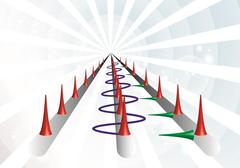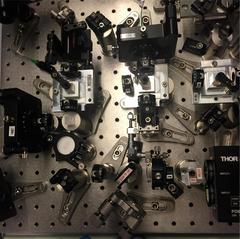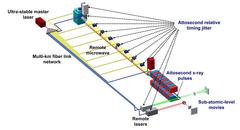URL: https://www.desy.de/news/news_search/index_eng.html
Breadcrumb Navigation
DESY News: Laser metronome achieves record synchronization
News
News from the DESY research centre
Laser metronome achieves record synchronization
Scientists at DESY have set up the world's most precise ‘metronome’ for a kilometre-wide network. The timing system synchronizes a 4.7-kilometer-long laser-microwave network with 950 attoseconds precision. An attosecond is a quintillionth of a second, or a millionth of a millionth of a millionth of a second. Such installations can provide the beat for recording ultrafast X-ray snapshots of dynamic processes in the world of molecules and atoms. The German-US team around leading DESY scientist Prof. Franz X. Kärtner from the Center for Free-Electron Laser Science (CFEL) in Hamburg reports the achievement in the scientific journal Light: Science & Applications.

Mode-locked lasers emit ultralow-noise optical pulse trains at microwave rates with extreme precision. Scientists at DESY have now developed such a laser metronome that can synchronise multiple lasers and microwave sources with attosecond precision in a kilometre-wide network for the first time. Credit: DESY/Polina Şafak
Research centres like DESY working on X-ray free-electron lasers (XFELs) aim to take snapshots of ultrafast processes in the nanocosmos, for instance structural dynamics of biomolecules or chemical reactions. “X-rays provide excellent spatial resolution on the scale of atoms,” explains Şafak. “The challenge is to achieve the necessary temporal resolution on the scale of attoseconds, where important molecular and atomic processes take place.”
DESY's pioneering free-electron laser FLASH already features an impressive facility-wide timing precision of 30 femtoseconds. This is important for so-called pump-probe experiments, where a dynamic process – a chemical reaction for instance – is started with one laser pulse and analysed with another laser pulse after a well-defined delay. Repeating the experiment with slowly increasing delay times yields a series of snapshots and creates a super slow-motion movie of the reaction or process under investigation. Without synchronization between the pulses, the dynamics cannot be resolved clearly in the movie.

View of a part of the laser set-up in the lab. Credit: DESY/Kemal Şafak
“Facilities like XFELs and laser-based attoscience centres require system-wide attosecond-level synchronization of dozens of optical and microwave signals, often over kilometre distances,” adds Kärtner. For this purpose, the researchers have developed an optical timing distribution system that uses the ultralow-noise pulse train from a mode-locked laser as its timing signal. Using stabilized fibre-optic links, the timing signal is transferred over a long distance from a central location to multiple end stations, where efficient and robust synchronization is realised with remote optical and microwave sources.

Schematic of the facility-wide synchronisation. Credit: DESY/Ming Xin
“The attosecond-precision laser-microwave network will enable next-generation XFELs and other scientific facilities to operate with unprecedented timing accuracy, helping them to unfold their full potential,” underlines Kärtner. “This will drive new scientific efforts towards the making of atomic and molecular movies at the attosecond timescale, thereby opening up many new research areas in biology, drug development, chemistry, fundamental physics and material science. Besides, this technique is also expected to accelerate developments in many other frontier research fields requiring high temporal resolution such as comparison of ultra-stable optical clocks, gravitational-wave astronomy and coherent optical antenna arrays.”
The experiments were carried out in CFEL laser labs. CFEL is a cooperation of DESY, the University of Hamburg and the Max Planck Society. DESY, MIT and the University of Hamburg were involved in this research.
Originalarbeit:
Attosecond precision multi-kilometer laser-microwave network; Ming Xin, Kemal Şafak, Michael Y. Peng, Aram Kalaydzhyan, Wenting Wang, Oliver D. Mücke, and Franz X. Kärtner; Light: Science & Applications (2017); DOI: 10.1038/lsa.2016.187
Video:
Kemal Şafak explaining the work on YouTube - https://www.youtube.com/watch?v=wi2n9VB9oc8



